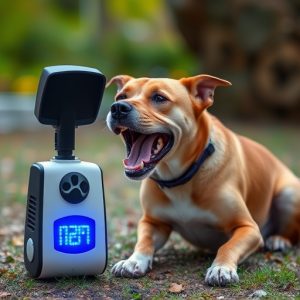Safe Ultrasonic Bark Control: Training Dogs Humanely
Safe ultrasonic frequencies (25-64 kHz) offer a humane solution for dog barking control. Electronic…….
Safe ultrasonic frequencies (25-64 kHz) offer a humane solution for dog barking control. Electronic devices emit inaudible sounds to disrupt excessive barking without causing harm, leveraging dogs' sensitive hearing. Choosing the right device with adjustable sensitivity and automated triggers ensures effectiveness tailored to individual dog behavior. Strategic placement of sensors and regular monitoring are key for optimal results, fostering happier living environments for pets and owners.
“Unleash a quieter home with the innovative solution: an electronic dog barking prevention system. This comprehensive guide explores the science behind safe ultrasonic frequencies, offering a humane approach to training your canine companion. We delve into understanding common bark triggers and provide strategic insights on device selection. Learn how these advanced systems can be implemented effectively, ensuring both peace and positive reinforcement for your pet. Discover the benefits of embracing modern technology for better dog behavior management.”
- Understanding Dog Barking Patterns and Their Causes
- The Science Behind Ultrasonic Frequencies for Dog Training
- Benefits of Using Safe and Humane Electronic Bark Control Systems
- How to Select the Right Ultrasonic Device for Your Dog's Behavior
- Implementing and Monitoring the System for Effective Results
Understanding Dog Barking Patterns and Their Causes
Dog barking is a complex behavior that can stem from various reasons, including anxiety, boredom, territorial instincts, or even attention-seeking. Understanding these patterns is crucial when implementing any solution for dog barking prevention. Different dogs have different triggers, and what works for one might not work for another. For instance, some dogs may bark due to separation anxiety, requiring a system that provides comfort and distraction, while others might be responding to external stimuli like passing cars or strangers.
Electronic systems designed to control dog barking often utilize safe ultrasonic frequencies as a deterrent. These frequencies are inaudible to humans but can effectively startle or distract dogs from barking excessively. The technology is non-harmful and operates by emitting high-frequency sound waves when the system detects a bark, which discourages the dog without causing any physical discomfort. Such systems offer a humane alternative to traditional punishment methods and allow for effective barking management while promoting positive reinforcement training.
The Science Behind Ultrasonic Frequencies for Dog Training
The Science Behind Ultrasonic Frequencies for Dog Training
When it comes to dog barking prevention, electronic systems utilizing ultrasonic frequencies have emerged as a safe and effective solution. These devices emit high-pitched sounds that are inaudible to humans but can be detected by dogs. The science behind this approach lies in dogs’ exceptional hearing sensitivity—they can hear sounds at frequencies up to 60 kHz, far beyond the human range of approximately 20 Hz to 20 kHz. By targeting these ultrasonic ranges, the system can effectively communicate with dogs without causing any harm.
The safe ultrasonic frequencies used in dog training and control are designed to be mild and non-invasive. They work by stimulating a dog’s natural response to avoid unpleasant stimuli. When a dog barks excessively, the ultrasonic signal is triggered, delivering a quiet, high-pitched sound that disrupts their barking pattern without causing physical discomfort or distress. This method has proven successful in modifying behavior while ensuring the well-being and comfort of the animal.
Benefits of Using Safe and Humane Electronic Bark Control Systems
Using electronic bark control systems that employ safe ultrasonic frequencies offers numerous benefits for both dogs and their owners. These advanced devices are designed to address excessive barking without causing harm or distress, ensuring the well-being of pets while providing a humane solution. Unlike traditional punishment methods, they don’t rely on negative reinforcement, making them ideal for responsible dog ownership.
The use of ultrasonic frequencies allows for precise targeting of dogs’ hearing ranges, triggering a mild response when they bark excessively. This approach is particularly effective because it disrupts the barking behavior without causing physical pain or long-term auditory damage. As a result, dogs learn to control their barking naturally over time, fostering a happier and healthier living environment for both the pet and its owner.
How to Select the Right Ultrasonic Device for Your Dog's Behavior
When choosing an ultrasonic device to prevent dog barking, it’s crucial to consider your pet’s unique behavior and well-being. Not all dogs respond to ultrasound in the same way, so selecting the right frequency is key. Opt for devices using safe, high-pitched frequencies specifically designed for canine use, typically between 25-64 kHz. This range is above human hearing but effectively alerts dogs without causing harm.
Research different models and read reviews from fellow dog owners to understand the effectiveness and any potential side effects. Look for features like adjustable sensitivity settings and automated activation triggers to tailor the device’s response to your dog’s barking patterns, ensuring a humane and targeted solution.
Implementing and Monitoring the System for Effective Results
Implementing an electronic dog barking prevention system requires careful consideration and consistent monitoring to achieve optimal results. The core technology, often employing safe ultrasonic frequencies for dog control, should be strategically placed around areas where unwanted barking occurs most frequently. These frequencies are designed to be inaudible to humans but irritating to dogs, effectively discouraging excessive barking without causing harm or distress.
Regular monitoring is key to the system’s effectiveness. Users should keep a close eye on their dog’s behavior, noting any patterns or triggers that set off the device. Adjustments can then be made accordingly, such as repositioning sensors or adjusting frequency settings, ensuring the system remains tailored to the specific needs of the canine and its environment.
Electronic bark control systems, specifically those employing safe ultrasonic frequencies, offer a humane and effective solution to dog barking issues. By understanding barking patterns, leveraging scientific principles, and selecting the right device, owners can ensure their pets receive positive training without causing them harm. Implementing and monitoring these systems consistently is key to achieving lasting behavioral changes. This approach not only benefits the dog’s well-being but also fosters a quieter and more harmonious environment for both the pet and its owners.


